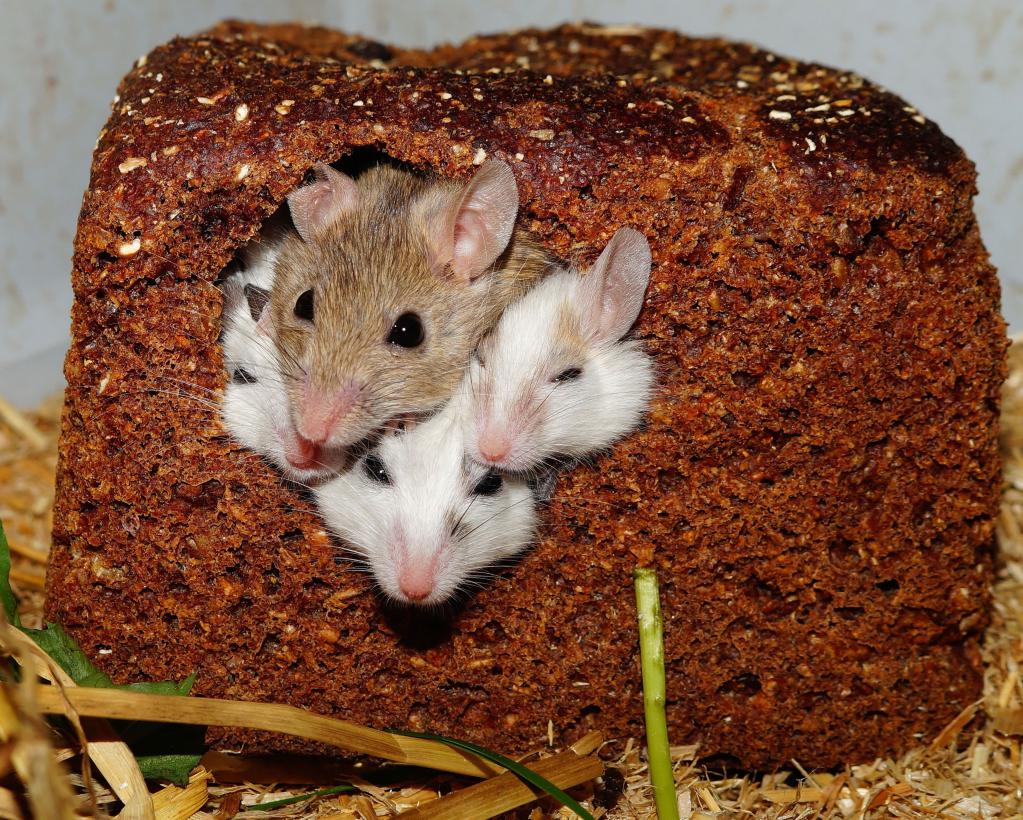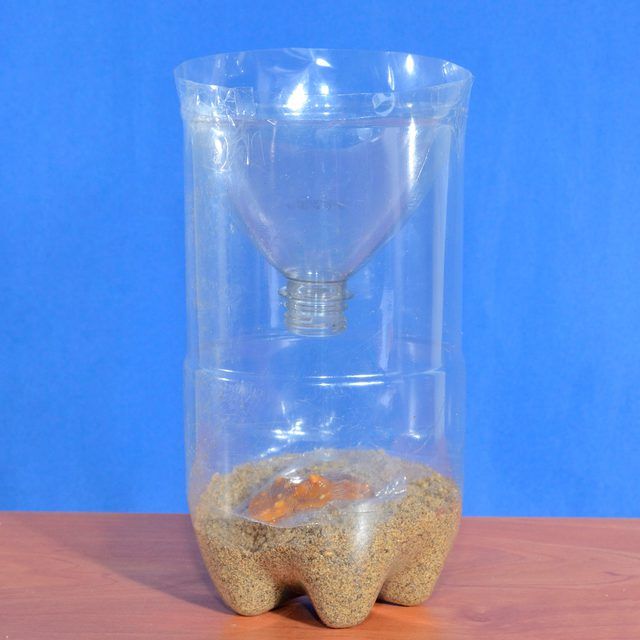Since ancient times, people haverodents, since they live everywhere, where there is food for them - from fields to megacities. Naturally, people do not like this neighborhood, since mice not only make noise and carry harm in themselves for products and furniture, but also suffer various infectious diseases. And the very fact of having such undesirable neighbors is not pleasurable, and therefore almost every person has a desire to get rid of them when mice appear. The easiest way is to leave the poison on the products in the places where the mouse was seen. But if the house has small children or pets, it is better not to take risks. It remains only to self-trap pests by tricking them with the help of a trap. In addition to factory traps, there are many different ways to make a mousetrap with your own hands, which will work no less effectively.

Varieties of self-made traps
For centuries of struggle with mice humanity has invented many ways to lure a rodent into a trap. Let us dwell on the most accessible ways of catching with the help of the following materials:
- Banks and papers.
- Banks with a lid.
- Banks with a coin.
- Plastic bottle.
- Plastic bottle with a bucket.
- Plastic bottle and gravity.
- Trap from a plastic bottle.
- Lures in the form of a support.
- Buckets and slats.
Trap from cans and paper
The essence of this mousetrap is reduced to the hit of a mouseInside the jar, from which it no longer gets out. To do this, writing paper is stretched on the neck of the jar, which creates the appearance of a solid surface. Above the jar a small piece of bait is hung in such a way that it can be reached only with stretched paper. The mouse will certainly try to get the bait, leaning on the front with its front paws, and it will fail. You can also make a similar mousetrap from the bottle with your own hands. So that the rodent could not grasp the neck, it should be wide enough. Perhaps this is the only nuance of such a mousetrap.
Mousetrap from can and lid
To build such a mousetrap with your own hands is simple, but it is suitable for catching one pest.
The ordinary bank with a wide neck is rolled uptin lid. After the surface of the lid is cut from the center on the sides of the edges in the form of a cake, and sharp teeth bend into the can. As a result, you should get a hole to hit the mouse in the jar, but the diameter is not more than the size of the mouse. At the end of the jar there must be a bait. As such, it is better to use lard, sausage, sunflower seeds or wheat grains. The mouse will surely attract the smell of bait, and it will get inside the jar. But to get away it will prevent sharp teeth, directed inwards.
Mousetrap from cans and coins
One of the oldest, simplest and not particularlyreliable home mousetrap with their own hands. It will only need a bank, a coin and a bait. On the inside of the jar, you should apply a bait that exudes a strong smell (for example, lard or peanut butter). The neck needs to be placed on the edge of a coin of a preferably large size so that the trap does not slam shut when the mouse penetrates the can. Since the coin very weakly holds the jar on its edge, and the neck of the jar is not so large that it is possible to easily circumambulate the coin, the incoming mouse will certainly hit it, and the bank will shut. The downside of such a mousetrap is the possibility of its "triggering" before the victim is under the can.

Mousetrap with your hands from a plastic bottle
Ловушки из пластиковых бутылок разнообразны и practically do not require any investments and materials, except for the plastic bottle itself. In doing so, they fulfill their function very effectively. Therefore, one of the simplest and most accessible ways to catch a mouse is to make a mousetrap from a plastic bottle with your own hands. To do this, a 2 liter plastic bottle is cut into 2 pieces so that the top part is one third of the bottle and the bottom one is two thirds. It turns out the top part of the bottle in the form of a watering can. After the bottom of the bottom of the bottle is put bait, and the top is inserted into the bottom and fastened with a stapler along the edges.

The neck of the watering can from the inside is lubricated by sunfloweroil to lower resistance. As a result, the mouse tries to reach the bait, trying to get into the neck of the bottle. Oil helps her to get into a trap, where she can not get out.
Mousetrap with a bucket and a plastic bottle
Adding a bucket in this method is provided for mass mice catching and placing them in a separate container. You can pour water into the bucket if you want to kill them right away.
So, in order to make by hand a mousetrap from a plastic bottle in this way, you need to have:
- bucket;
- long needle or other rigid twig;
- a plastic bottle;
- Scotch;
- bait.
To make such a trap simple:A needle is threaded along the center of the upper and lower parts along the bottle. This is necessary in order to ensure the free rotation of the bottle without preponderance. The bottle is in the middle relative to the edges of the knitting needle. Now you need to fix the bait with adhesive tape along its perimeter. It is enough to "walk" one time in the middle of the bottle. To make the bait produce more odor, do not completely cover it with scotch tape. Next, the spoke with the bottle lies on the edges of the bucket. If you want to catch a lot of mice, then for greater reliability of the design it is worthwhile to punch holes at the edges of the bucket to pass the edges of the spoke. The latter, together with the bottle, should rotate freely. Finally, one or two racks are installed on both sides of the bucket so that the mouse can reach the bottle with the bait.

The principle of such a trap isthat the mouse climbs on the bottle for bait, as it is attached in the middle of the bottle. Leaning on the bottle, the rodent inevitably falls into the bucket because the bottle scrolls under its weight.
Mousetrap with the help of gravity
The next simple way with which you can make a mousetrap with your hands on the basis of a plastic bottle, will be its use with gravity:
- The top of the plastic bottle is cut to make a hole that is sufficient to allow the mouse to hit the inside of the bottle.
- A rope is attached to the edge of the bottle.
- At the bottom of the bottle is put a bait, and a bottleIt is installed on the edge of a table or other surface on a hill. Part of the bottle with the bait should be beyond the edge of the surface, but it should not fall.
- The other side of the rope is attached to the surface. The rope must have a length that, when dropped, the bottle completely sags under the edge of the surface and does not fall to the floor.

As a result, the mouse penetrates into the bottle to getbefore the bait, and under its own weight falls along with the bottle from the edge of the surface. At the same time, the bottle is held on the rope together with the prey until it is removed.
Trap made of plastic bottle
A very effective way to catch the rodent in the shortest time possible in a mousetrap made by one's own hands. Moreover, such a trap does not require anything other than a plastic bottle.
So, cut off half of the plastic bottle.The edges must remain flat. On all diameter it is necessary to cut petals with sharp edges in length slightly more than radius of a bottle. The length of the petals is also very important to observe. Doing them should not be too narrow, since they will have to hold the mouse in the trap. The resulting petals are bent inside and slightly pushed, forming a hole for mouse penetration. Thus, it is not difficult to get into the bottle from the outside of the rodent, but to get out of there will not give him sharp petals.
Mousetrap with bait in the form of a support
Among the hand-made mousetraps inat home, this is the most common. Take any capacity in the form of a bowl or bowl of small volume, sufficient to hold the mouse. It turns upside down, and under it is laid bait. It should be of such a size that it could lift the container to a height sufficient to penetrate the inside of the mouse. You can also use two sticks, which will be attached to the bait. Thus, when a mouse eats a treat, it simultaneously destroys the support that holds the container above it. As a result, the plate is covered by a rodent. Below the photo shows the principle of the operation of such a trap.

Trap with bucket and bar
This method is also focused on mass capture of mice. It would be easy to build such a mousetrap with your own hands. You only need a lath, bucket, knitting needle and bait.
First you need to prepare the bar lengthslightly more than the radius of the top of the bucket. It is mounted on a knitting needle or other hard rod, which, in turn, is installed on the edges of the bucket. To this edge you need to ensure the approach of mice, putting a plate or putting a bucket next to a similar hill. A lure is put on the edge of the bar, after which the rodent should fall into the bucket, as the trap should fall down under the weight of the mouse. Therefore, the needle should be mounted in such a part of the plank so that the bait does not outweigh it, but overturned only when the mouse crosses the point of no return. Such is the place of fastening the spokes on the bar. As a slat, you can use polystyrene foam, which is quite able to withstand a mouse. He also makes a very simple knitting needle and cuts.
Below the photo shows another version of such a trap, where the bar goes through the entire diameter of the bucket and is attached in the middle.

Instead of strips in this design is still usedcover of smaller diameter. You just need to fix the needle in the center of the lid and put in the middle of the bucket. The bait should also be in the center. The main thing is that the cover after installation can be in a horizontal position. The effect will be the same as with the strap.
Of course, you can not design your own handsmousetrap, but just buy it. But the effectiveness of most of the traps invented by the people is proven in practice and does not require costs. They are used much more often than factory traps, glue-based traps or ultrasonic repellents.












